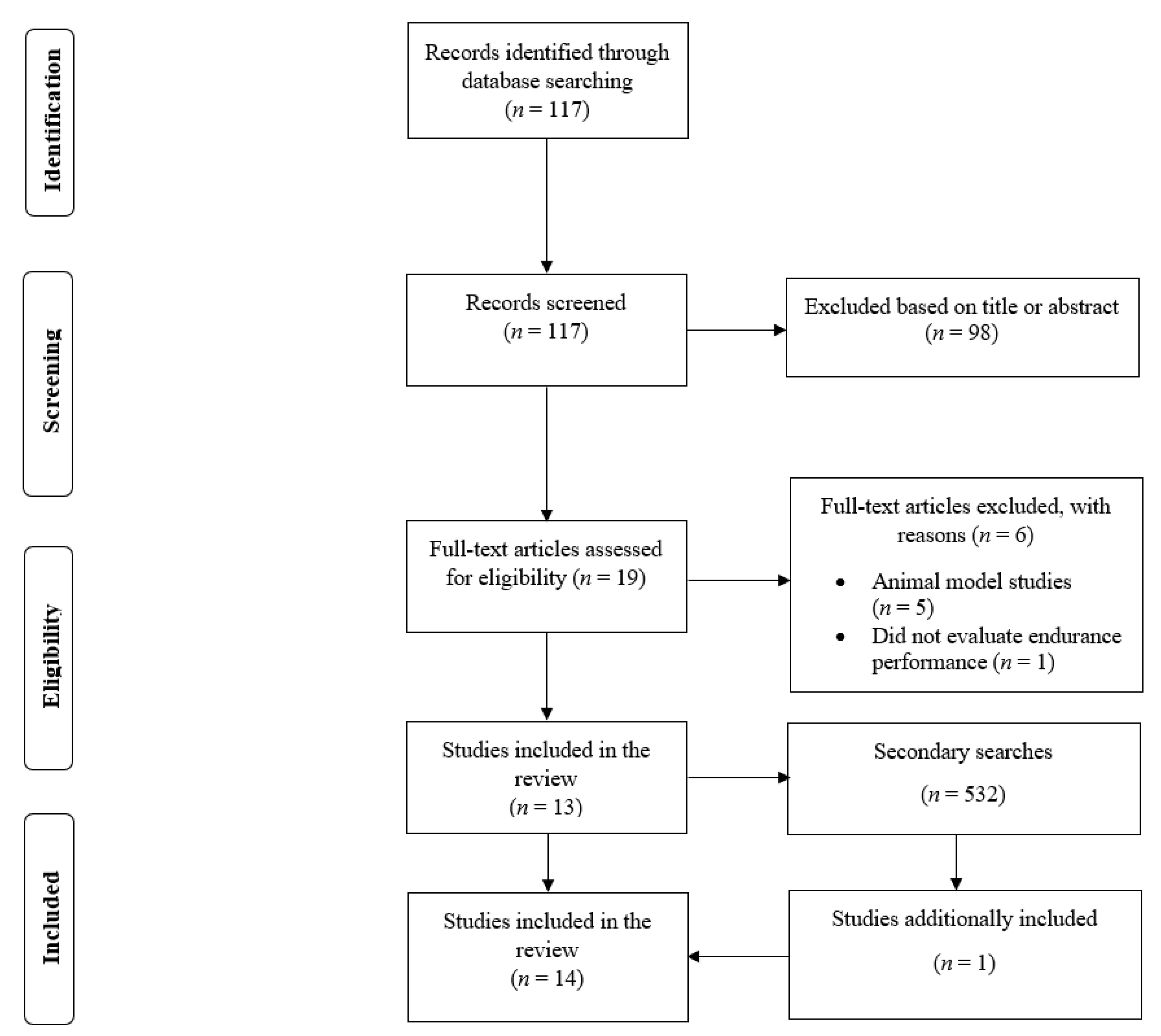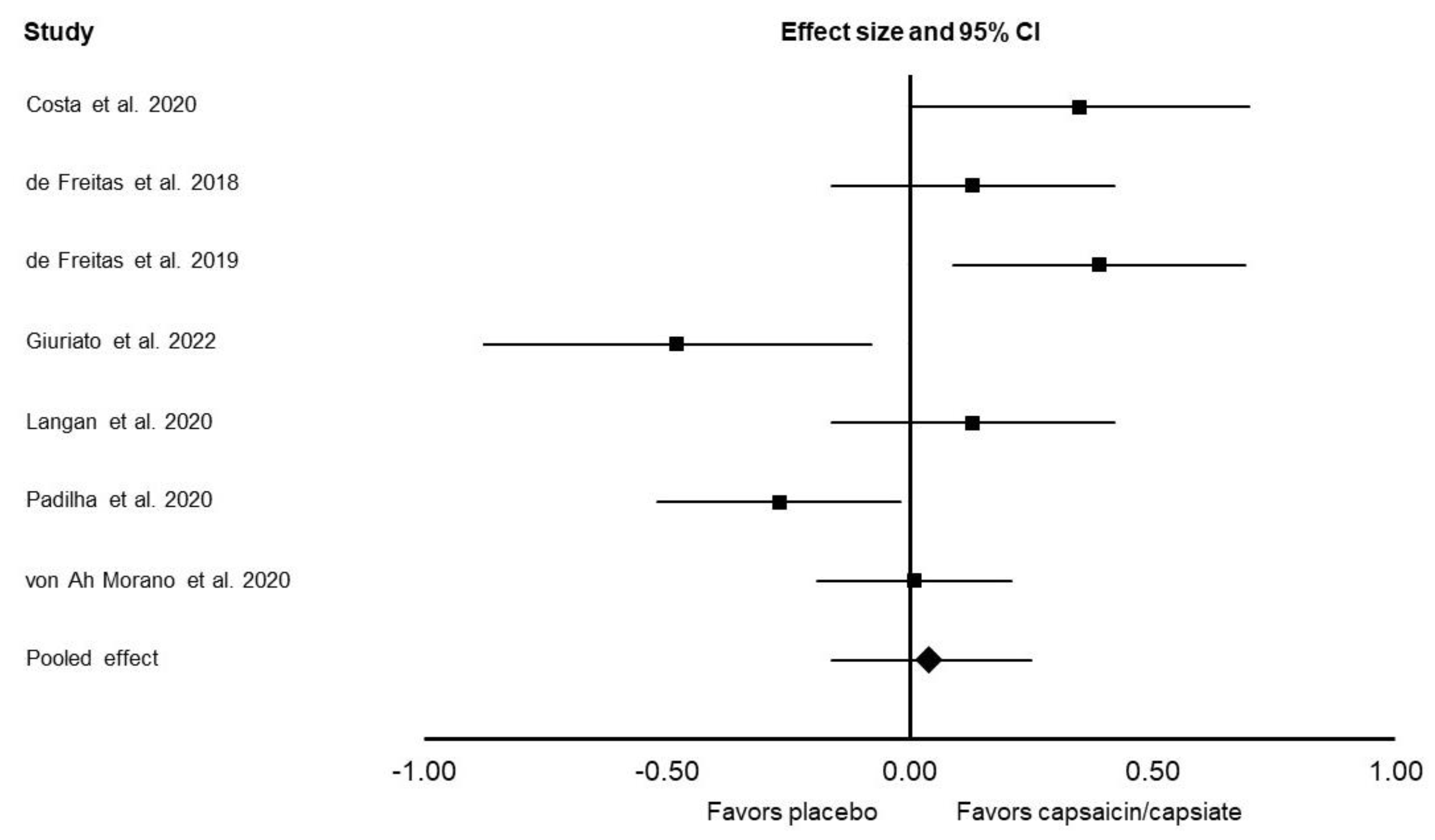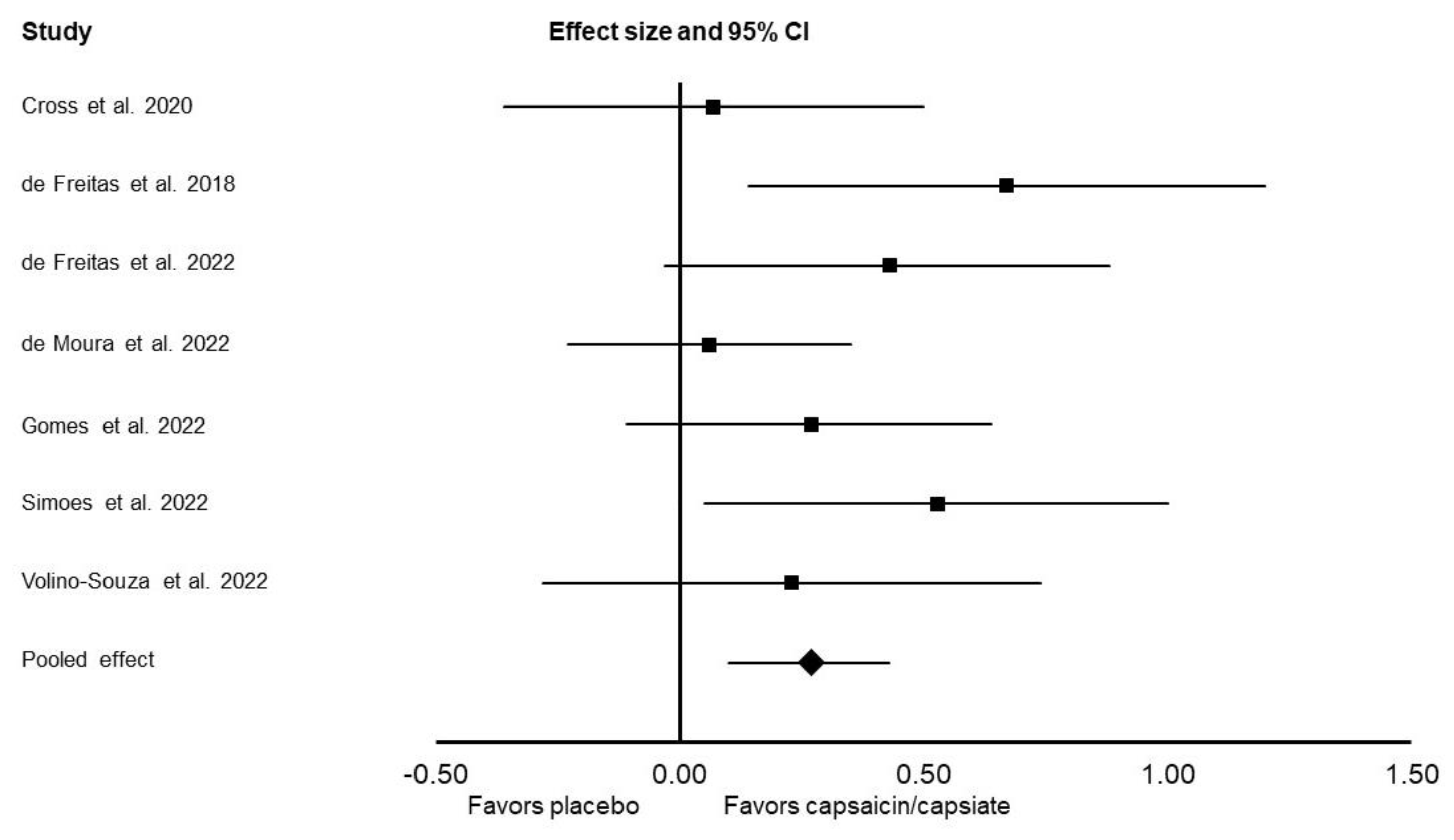Effects of Capsaicin and Capsiate on Endurance Performance: A Meta-Analysis
Abstract
:1. Introduction
2. Materials and Methods
2.1. Search Strategy
2.2. Inclusion Criteria
- Population (P): healthy adult human participants
- Interventions (I): acute, pre-exercise, capsaicin and/or capsiate supplementation
- Comparison (C): placebo
- Outcome (O): aerobic endurance (e.g., cycling time-trial) or muscular endurance performance (e.g., repetitions performed to muscular failure)
2.3. Data Extraction
- Lead author name and year of study publication
- Study design
- Participants’ characteristics (e.g., sex, training status)
- Supplementation protocols
- Description of the performance test
- Mean ± standard deviation performance and RPE data recorded in the placebo and experimental trials
2.4. Risk of Bias Assessment
2.5. Statistical Analysis
3. Results
3.1. Search Results
3.2. Summary of the Included Studies
3.3. Risk of Bias
3.4. Meta-Analysis for Aerobic Endurance
3.5. Meta-Analysis for Muscular Endurance
4. Discussion
5. Conclusions
Author Contributions
Funding
Institutional Review Board Statement
Informed Consent Statement
Data Availability Statement
Conflicts of Interest
References
- Ludy, M.J.; Moore, G.E.; Mattes, R.D. The effects of capsaicin and capsiate on energy balance: Critical review and meta-analyses of studies in humans. Chem. Senses 2012, 37, 103–121. [Google Scholar] [CrossRef] [PubMed] [Green Version]
- Iwai, K.; Yazawa, A.; Watanabe, T. Roles as metabolic regulators of the non-nutrients, capsaicin and capsiate, supplemented to diets. Proc. Jpn. Acad. 2003, 79, 207–212. [Google Scholar] [CrossRef] [Green Version]
- Ohnuki, K.; Niwa, S.; Maeda, S.; Inoue, N.; Yazawa, S.; Fushiki, T. CH-19 sweet, a non-pungent cultivar of red pepper, increased body temperature and oxygen consumption in humans. Biosci. Biotechnol. Biochem. 2001, 65, 2033–2036. [Google Scholar] [CrossRef] [PubMed]
- de Moura, E.; Silva, V.E.L.; Cholewa, J.M.; Billaut, F.; Jäger, R.; de Freitas, M.C.; Lira, F.S.; Rossi, F.E. Capsaicinoid and capsinoids as an ergogenic aid: A systematic review and the potential mechanisms involved. Int. J. Sport. Physiol. Perform. 2021, 16, 464–473. [Google Scholar] [CrossRef]
- Xu, Y.; Zhao, Y.; Gao, B. Role of TRPV1 in high temperature-induced mitochondrial biogenesis in skeletal muscle: A mini review. Front. Cell. Dev. Biol. 2022, 10, 882578. [Google Scholar] [CrossRef]
- Lotteau, S.; Ducreux, S.; Romestaing, C.; Legrand, C.; Van Coppenolle, F. Characterization of functional TRPV1 channels in the sarcoplasmic reticulum of mouse skeletal muscle. PLoS ONE 2013, 8, e58673. [Google Scholar] [CrossRef] [Green Version]
- Derry, S.; Rice, A.S.; Cole, P.; Tan, T.; Moore, R.A. Topical capsaicin (high concentration) for chronic neuropathic pain in adults. Cochrane Database Syst. Rev. 2017, 1, CD007393. [Google Scholar]
- Yang, D.; Luo, Z.; Ma, S.; Wong, W.T.; Ma, L.; Zhong, J.; He, H.; Zhao, Z.; Cao, T.; Yan, Z.; et al. Activation of TRPV1 by dietary capsaicin improves endothelium-dependent vasorelaxation and prevents hypertension. Cell Metab. 2010, 12, 130–141. [Google Scholar] [CrossRef] [Green Version]
- Bescós, R.; Sureda, A.; Tur, J.A.; Pons, A. The effect of nitric-oxide-related supplements on human performance. Sport. Med. 2012, 42, 99–117. [Google Scholar] [CrossRef]
- Kim, K.M.; Kawada, T.; Ishihara, K.; Inoue, K.; Fushiki, T. Increase in swimming endurance capacity of mice by capsaicin-induced adrenal catecholamine secretion. Biosci. Biotechnol. Biochem. 1997, 61, 1718–1723. [Google Scholar] [CrossRef]
- Kazuya, Y.; Tonson, A.; Pecchi, E.; Dalmasso, C.; Vilmen, C.; Fur, Y.L.; Bernard Bendahan, D.; Giannesini, B. A single intake of capsiate improves mechanical performance and bioenergetics efficiency in contracting mouse skeletal muscle. Am. J. Physiol. Endocrinol. Metab. 2014, 306, E1110–E1119. [Google Scholar] [CrossRef]
- Costa, L.A.; Freitas, M.C.; Cholewa, J.M.; Panissa, V.L.G.; Nakamura, F.Y.; Silva, V.E.L.M.; Sá, A.M.; Rossi, P.A.Q.; Ribeiro, S.L.G.; Santos, M.A.P.; et al. Acute capsaicin analog supplementation improves 400 m and 3000 m running time-trial performance. Int. J. Exerc. Sci. 2020, 13, 755–765. [Google Scholar] [PubMed]
- Cross, B.L.; Parker, D.; Langan, S.P.; Grosicki, G.J. Effect of a commercially available low-dose capsaicin supplement on knee extensor contractile function. Int. J. Exerc. Sci. 2020, 13, 312–318. [Google Scholar] [PubMed]
- de Freitas, M.; Cholewa, J.M.; Freire, R.V.; Carmo, B.A.; Bottan, J.; Bratfich, M.; Della Bandeira, M.P.; Gonçalves, D.C.; Caperuto, E.C.; Lira, F.S.; et al. Acute capsaicin supplementation improves resistance training performance in trained men. J. Strength Cond. Res. 2018, 32, 2227–2232. [Google Scholar] [CrossRef] [PubMed]
- de Freitas, M.C.; Cholewa, J.M.; Gobbo, L.A.; de Oliveira, J.V.N.S.; Lira, F.S.; Rossi, F.E. Acute capsaicin supplementation improves 1,500-m running time-trial performance and rate of perceived exertion in physically active adults. J. Strength Cond. Res. 2018, 32, 572–577. [Google Scholar] [CrossRef] [PubMed]
- de Freitas, M.C.; Billaut, F.; Panissa, V.L.G.; Rossi, F.E.; Figueiredo, C.; Caperuto, E.C.; Lira, F.S. Capsaicin supplementation increases time to exhaustion in high-intensity intermittent exercise without modifying metabolic responses in physically active men. Eur. J. Appl. Physiol. 2019, 119, 971–979. [Google Scholar] [CrossRef]
- de Freitas, M.C.; Cholewa, J.M.; Panissa, V.L.G.; Toloi, G.G.; Netto, H.C.; Zanini de Freitas, C.; Freire, R.V.; Lira, F.S.; Rossi, F.E. Acute capsaicin supplementation improved resistance exercise performance performed after a high-intensity intermittent running in resistance-trained men. J. Strength Cond. Res. 2022, 36, 130–134. [Google Scholar] [CrossRef]
- de Moura, H.P.; Cholewa, J.M.; Jaeger, R.; Campos, E.Z.; Rosa, B.V.; Nunes, F.A.; Barros, C.C.; Rossi, P.A.; Gerosa-Neto, J.; Zanchi, N.E.; et al. Acute low-dose capsiate supplementation improves upper body resistance exercise performance in trained men: A randomized, crossover and double-blind study. Int. J. Exerc. Sci. 2022, 15, 1007–1018. [Google Scholar]
- Giuriato, G.; Venturelli, M.; Matias, A.; Soares, E.M.K.V.K.; Gaetgens, J.; Frederick, K.A.; Ives, S.J. Capsaicin and its effect on exercise performance, fatigue and inflammation after exercise. Nutrients 2022, 14, 232. [Google Scholar] [CrossRef]
- Gomes, W.; de Freitas, M.C.; Dutra, Y.M.; Rossi, F.; Estanislau, T.B.; Gonçalves, D.C.; Campos, E.Z. Effects of capsiate supplementation on maximal voluntary contraction in healthy men. Int. J. Sport. Med. 2022, 43, 466–472. [Google Scholar]
- Langan, S.P.; Grosicki, G.J. Commercially available capsaicin supplement fails to enhance time-to-exhaustion during cycling. Int. J. Exerc. Sci. 2020, 13, 225–233. [Google Scholar] [PubMed]
- Padilha, C.S.; Billaut, F.; Figueiredo, C.; Panissa, V.L.G.; Rossi, F.E.; Lira, F.S. Capsaicin supplementation during high-intensity continuous exercise: A double-blind study. Int. J. Sport. Med. 2020, 41, 1061–1066. [Google Scholar] [CrossRef] [PubMed]
- Simões, C.B.; Gomes, P.L.; Silva, R.A.; Fonseca, I.; Fonseca, M.; Cruz, V.M.; Drummond, M.D. Acute caffeine and capsaicin supplementation and performance in resistance training. Mot. Rev. Educ. Física 2022, 13, 1–7. [Google Scholar] [CrossRef]
- Volino-Souza, M.; de Oliveira, G.V.; de Carvalho, I.H.; Conte-Junior, C.A.; da Silveira Alvares, T. Capsaicin supplementation did not increase skeletal muscle oxygen saturation and muscular endurance during resistance exercise: A randomized and crossover study. Sport. Sci. Health 2022. [Google Scholar] [CrossRef]
- von Ah Morano, A.E.; Padilha, C.S.; Soares, V.A.M.; Andrade Machado, F.; Hofmann, P.; Rossi, F.E.; Lira, F.S. Capsaicin analogue supplementation does not improve 10 km running time-trial performance in male amateur athletes: A randomized, crossover, double-blind and placebo-controlled study. Nutrients 2020, 13, 34. [Google Scholar] [CrossRef] [PubMed]
- Moher, D.; Liberati, A.; Tetzlaff, J.; Altman, D.G.; PRISMA Group. Preferred reporting items for systematic reviews and meta-analyses: The PRISMA statement. PLoS Med. 2009, 6, e1000097. [Google Scholar] [CrossRef] [Green Version]
- Higgins, J.; Li, T.; Altman, D.; Curtin, F.; Senn, S. Revised cochrane risk of bias tool for randomized trials (RoB 2). additional considerations for crossover trials. Cochrane 2020, 1, 1–16. [Google Scholar]
- Cohen, J. A power primer. Psychol. Bull. 1992, 112, 155–159. [Google Scholar] [CrossRef]
- Laursen, P.B.; Francis, G.T.; Abbiss, C.R.; Newton, M.J.; Nosaka, K. Reliability of time-to-exhaustion versus time-trial running tests in runners. Med. Sci. Sport. Exerc. 2007, 39, 1374–1379. [Google Scholar] [CrossRef]
- Lejeune, M.P.; Kovacs, E.M.; Westerterp-Plantenga, M.S. Effect of capsaicin on substrate oxidation and weight maintenance after modest body-weight loss in human subjects. Br. J. Nutr. 2003, 90, 651–659. [Google Scholar] [CrossRef] [Green Version]
- Evans, V.; Koh, R.G.L.; Duarte, F.C.K.; Linde, L.; Amiri, M.; Kumbhare, D. A randomized double blinded placebo controlled study to evaluate motor unit abnormalities after experimentally induced sensitization using capsaicin. Sci. Rep. 2021, 11, 13793. [Google Scholar] [CrossRef] [PubMed]
- Kaufman, M.P.; Iwamoto, G.A.; Longhurst, J.C.; Mitchell, J.H. Effects of capsaicin and bradykinin on afferent fibers with ending in skeletal muscle. Circ. Res. 1982, 50, 133–139. [Google Scholar] [CrossRef] [PubMed] [Green Version]
- Mannozzi, J.; Al-Hassan, M.H.; Lessanework, B.; Alvarez, A.; Senador, D.; O’Leary, D.S. Chronic ablation of TRPV1-sensitive skeletal muscle afferents attenuates the muscle metaboreflex. Am. J. Physiol. Regul. Integr. Comp. Physiol. 2021, 321, R385–R395. [Google Scholar] [CrossRef] [PubMed]
- Taylor, J.L.; Amann, M.; Duchateau, J.; Meeusen, R.; Rice, C.L. Neural contributions to muscle fatigue. Med. Sci. Sport. Exerc. 2016, 48, 2294–2306. [Google Scholar] [CrossRef]
- Humburg, H.; Baars, H.; Schröder, J.; Reer, R.; Braumann, K.M. 1-set vs. 3-set resistance training: A crossover study. J. Strength Cond. Res. 2007, 21, 578–582. [Google Scholar] [CrossRef] [PubMed]
- Warren, G.L.; Park, N.D.; Maresca, R.D.; McKibans, K.I.; Millard-Stafford, M.L. Effect of caffeine ingestion on muscular strength and endurance: A meta-analysis. Med. Sci. Sport. Exerc. 2010, 42, 1375–1387. [Google Scholar] [CrossRef]
- Polito, M.D.; Souza, D.A.; Casonatto, J.; Farinatti, P. Acute effect of caffeine consumption on isotonic muscular strength and endurance: A systematic review and meta-analysis. Sci. Sport. 2016, 31, 119–128. [Google Scholar] [CrossRef]
- Grgic, J.; Del Coso, J. Ergogenic effects of acute caffeine intake on muscular endurance and muscular strength in women: A meta-analysis. Int. J. Environ. Res. Public Health 2021, 18, 5773. [Google Scholar] [CrossRef]
- Grgic, J.; Rodriguez, R.F.; Garofolini, A.; Saunders, B.; Bishop, D.J.; Schoenfeld, B.J.; Pedisic, Z. Effects of sodium bicarbonate supplementation on muscular strength and endurance: A systematic review and meta-analysis. Sport. Med. 2020, 50, 1361–1375. [Google Scholar] [CrossRef]
- Grgic, J.; Pedisic, Z.; Saunders, B.; Artioli, G.G.; Schoenfeld, B.J.; McKenna, M.J.; Bishop, D.J.; Kreider, R.B.; Stout, J.R.; Kalman, D.S.; et al. International Society of Sports Nutrition position stand: Sodium bicarbonate and exercise performance. J. Int. Soc. Sport. Nutr. 2021, 18, 61. [Google Scholar] [CrossRef]
- Alvares, T.S.; Oliveira, G.V.; Volino-Souza, M.; Conte-Junior, C.A.; Murias, J.M. Effect of dietary nitrate ingestion on muscular performance: A systematic review and meta-analysis of randomized controlled trials. Crit. Rev. Food Sci. Nutr. 2022, 62, 5284–5306. [Google Scholar] [CrossRef] [PubMed]
- Burke, L.M. Practical issues in evidence-based use of performance supplements: Supplement interactions, repeated use and individual responses. Sport. Med. 2017, 47, 79–100. [Google Scholar] [CrossRef] [PubMed] [Green Version]
- Saunders, B.; de Oliveira, L.F.; da Silva, R.P.; de Salles Painelli, V.; Gonçalves, L.S.; Yamaguchi, G.; Mutti, T.; Maciel, E.; Roschel, H.; Artioli, G.G.; et al. Placebo in sports nutrition: A proof-of-principle study involving caffeine supplementation. Scand. J. Med. Sci. Sport. 2017, 27, 1240–1247. [Google Scholar] [CrossRef] [PubMed]



| Studies on the Effects of Capsaicin and Capsiate on Aerobic Endurance | |||
| Reference | Participants | Supplementation Protocol | Performance Test |
| Costa et al. [12] | 12 physically active males | 12 mg of capsiate 45 min before exercise | 400-m and 3000-m running |
| de Freitas et al. [15] | 10 physically active males | 12 mg of capsaicin 45 min before exercise | 1500-m running |
| de Freitas et al. [16] | 13 physically active males | 12 mg of capsaicin 45 min before exercise | Interval running to exhaustion |
| Giuriato et al. [19] | 10 young males | 2 × 3.9 mg of capsaicin 50 min before exercise | Cycling to exhaustion at 85% of maximal work rate |
| Langan et al. [21] | 13 recreationally active females and males | 1.2 mg of capsaicin 45 min before exercise | Cycling to exhaustion at 90% of VO2max |
| Padilha et al. [22] | 15 recreationally trained male runners | 12 mg of capsaicin 45 min before exercise | Running to exhaustion at 90% of VO2peak |
| von Ah Morano et al. [25] | 21 male amateur athletes | 12 mg of capsiate 45 min before exercise | 10-km cycling time-trial |
| Studies on the Effects of Capsaicin and Capsiate on Muscular Endurance | |||
| Reference | Participants | Supplementation Protocol | Performance Test |
| Cross et al. [13] | 9 recreationally active females and males | 1.2 mg of capsaicin 45 min before exercise | 120 maximal isokinetic knee extensions |
| de Freitas et al. [14] | 10 resistance-trained males | 12 mg of capsaicin 45 min before exercise | 4 sets of squats to muscular failure with 70% of 1RM |
| de Freitas et al. [17] | 11 resistance-trained males | 12 mg of capsaicin 45 min before exercise and 12 mg of capsaicin immediately before exercise | 4 sets of squats to muscular failure with 70% of 1RM performed after a 5-km run |
| de Moura et al. [18] | 20 resistance-trained males | 6 or 12 mg of capsiate 45 min before exercise | 4 sets of bench press to muscular failure with 70% of 1RM |
| Gomes et al. [20] | 13 resistance-trained males | 12 mg of capsiate 45 min before exercise | Five sets of 10-s knee extension MVC |
| Simoes et al. [23] | 11 resistance-trained males | 12 mg of capsaicin 45 min before exercise | 4 sets of squats to muscular failure with 70% of 1RM |
| Volino-Souza et al. [24] | 8 resistance-trained males | 12 mg of capsaicin 45 min before exercise | 3 sets of leg extension to muscular failure at 70% of 1RM |
| Reference | Domain 1 | Domain S | Domain 2 | Domain 3 | Domain 4 | Domain 5 | Overall |
|---|---|---|---|---|---|---|---|
| Costa et al. [12] | Some concerns | Low risk | Low risk | Low risk | Some concerns | Low risk | Some concerns |
| Cross et al. [13] | Some concerns | Low risk | Low risk | Low risk | Some concerns | Low risk | Some concerns |
| de Freitas et al. [14] | Some concerns | Low risk | Low risk | Low risk | Low risk | Low risk | Some concerns |
| de Freitas et al. [15] | Some concerns | Low risk | Low risk | Low risk | Some concerns | Low risk | Some concerns |
| de Freitas et al. [16] | Some concerns | Low risk | Low risk | Low risk | Some concerns | Low risk | Some concerns |
| de Freitas et al. [17] | Some concerns | Low risk | Low risk | Low risk | Some concerns | Low risk | Some concerns |
| de Moura et al. [18] | Low risk | Low risk | Low risk | High risk | Some concerns | Low risk | High risk |
| Giuriato et al. [19] | Some concerns | Low risk | Some concerns | Low risk | Some concerns | Low risk | Some concerns |
| Gomes et al. [20] | Low risk | Low risk | Low risk | Low risk | Some concerns | Low risk | Some concerns |
| Langan et al. [21] | Some concerns | Low risk | Some concerns | Low risk | Some concerns | Low risk | Some concerns |
| Padilha et al. [22] | Some concerns | Low risk | Low risk | Low risk | Some concerns | Low risk | Some concerns |
| Simoes et al. [23] | Some concerns | Low risk | Low risk | Low risk | Some concerns | Low risk | Some concerns |
| Volino-Souza et al. [24] | Some concerns | Some concerns | Low risk | Low risk | Some concerns | Some concerns | Some concerns |
| von Ah Morano et al. [25] | Low risk | Some concerns | Low risk | Some concerns | Some concerns | Some concerns | Some concerns |
Publisher’s Note: MDPI stays neutral with regard to jurisdictional claims in published maps and institutional affiliations. |
© 2022 by the authors. Licensee MDPI, Basel, Switzerland. This article is an open access article distributed under the terms and conditions of the Creative Commons Attribution (CC BY) license (https://creativecommons.org/licenses/by/4.0/).
Share and Cite
Grgic, J.; Memon, A.R.; Chen, S.; Ramirez-Campillo, R.; Barreto, G.; Haugen, M.E.; Schoenfeld, B.J. Effects of Capsaicin and Capsiate on Endurance Performance: A Meta-Analysis. Nutrients 2022, 14, 4531. https://doi.org/10.3390/nu14214531
Grgic J, Memon AR, Chen S, Ramirez-Campillo R, Barreto G, Haugen ME, Schoenfeld BJ. Effects of Capsaicin and Capsiate on Endurance Performance: A Meta-Analysis. Nutrients. 2022; 14(21):4531. https://doi.org/10.3390/nu14214531
Chicago/Turabian StyleGrgic, Jozo, Aamir Raoof Memon, Sitong Chen, Rodrigo Ramirez-Campillo, Gabriel Barreto, Markus Estifanos Haugen, and Brad J. Schoenfeld. 2022. "Effects of Capsaicin and Capsiate on Endurance Performance: A Meta-Analysis" Nutrients 14, no. 21: 4531. https://doi.org/10.3390/nu14214531
APA StyleGrgic, J., Memon, A. R., Chen, S., Ramirez-Campillo, R., Barreto, G., Haugen, M. E., & Schoenfeld, B. J. (2022). Effects of Capsaicin and Capsiate on Endurance Performance: A Meta-Analysis. Nutrients, 14(21), 4531. https://doi.org/10.3390/nu14214531








